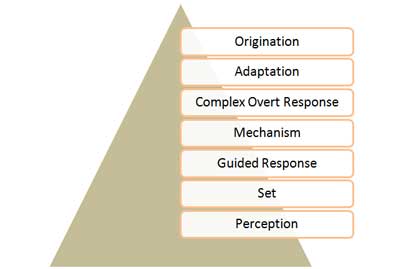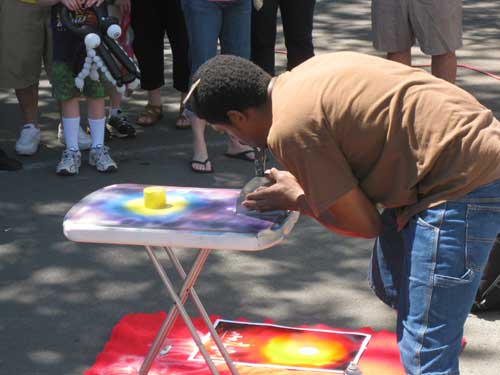Note: This site is moving to KnowledgeJump.com. Please reset your bookmark.
Bloom's Taxonomy: The Psychomotor Domain

 The psychomotor domain (Simpson, 1972) includes physical movement, coordination, and use of the motor-skill areas. Development of these skills requires practice and is measured in terms of speed, precision, distance, procedures, or techniques in execution. Thus, psychomotor skills rage from manual tasks, such as digging a ditch or washing a car, to more complex tasks, such as operating a complex piece of machinery or dancing.
The psychomotor domain (Simpson, 1972) includes physical movement, coordination, and use of the motor-skill areas. Development of these skills requires practice and is measured in terms of speed, precision, distance, procedures, or techniques in execution. Thus, psychomotor skills rage from manual tasks, such as digging a ditch or washing a car, to more complex tasks, such as operating a complex piece of machinery or dancing.
The seven major categories are listed from the simplest behavior to the most complex:
Category |
Example and Key Words (verbs) |
Perception (awareness): The ability to use sensory cues to guide motor activity. This ranges from sensory stimulation, through cue selection, to translation. |
Examples: Detects non-verbal communication cues. Estimate where a ball will land after it is thrown and then moving to the correct location to catch the ball. Adjusts heat of stove to correct temperature by smell and taste of food. Adjusts the height of the forks on a forklift by comparing where the forks are in relation to the pallet. Key Words: chooses, describes, detects, differentiates, distinguishes, identifies, isolates, relates, selects. |
Set: Readiness to act. It includes mental, physical, and emotional sets. These three sets are dispositions that predetermine a person's response to different situations (sometimes called mindsets). |
Examples: Knows and acts upon a sequence of steps in a manufacturing process. Recognize one's abilities and limitations. Shows desire to learn a new process (motivation). NOTE: This subdivision of Psychomotor is closely related with the “Responding to phenomena” subdivision of the Affective domain. Key Words: begins, displays, explains, moves, proceeds, reacts, shows, states, volunteers. |
Guided Response: The early stages in learning a complex skill that includes imitation and trial and error. Adequacy of performance is achieved by practicing. |
Examples: Performs a mathematical equation as demonstrated. Follows instructions to build a model. Responds hand-signals of instructor while learning to operate a forklift. Key Words: copies, traces, follows, react, reproduce, responds |
Mechanism (basic proficiency): This is the intermediate stage in learning a complex skill. Learned responses have become habitual and the movements can be performed with some confidence and proficiency. |
Examples: Use a personal computer. Repair a leaking faucet. Drive a car. Key Words: assembles, calibrates, constructs, dismantles, displays, fastens, fixes, grinds, heats, manipulates, measures, mends, mixes, organizes, sketches. |
Complex Overt Response (Expert): The skillful performance of motor acts that involve complex movement patterns. Proficiency is indicated by a quick, accurate, and highly coordinated performance, requiring a minimum of energy. This category includes performing without hesitation, and automatic performance. For example, players are often utter sounds of satisfaction or expletives as soon as they hit a tennis ball or throw a football, because they can tell by the feel of the act what the result will produce. |
Examples: Maneuvers a car into a tight parallel parking spot. Operates a computer quickly and accurately. Displays competence while playing the piano. Key Words: assembles, builds, calibrates, constructs, dismantles, displays, fastens, fixes, grinds, heats, manipulates, measures, mends, mixes, organizes, sketches. NOTE: The Key Words are the same as Mechanism, but will have adverbs or adjectives that indicate that the performance is quicker, better, more accurate, etc. |
Adaptation: Skills are well developed and the individual can modify movement patterns to fit special requirements. |
Examples: Responds effectively to unexpected experiences. Modifies instruction to meet the needs of the learners. Perform a task with a machine that it was not originally intended to do (machine is not damaged and there is no danger in performing the new task). Key Words: adapts, alters, changes, rearranges, reorganizes, revises, varies. |
Origination: Creating new movement patterns to fit a particular situation or specific problem. Learning outcomes emphasize creativity based upon highly developed skills. |
Examples: Constructs a new theory. Develops a new and comprehensive training programming. Creates a new gymnastic routine. Key Words: arranges, builds, combines, composes, constructs, creates, designs, initiate, makes, originates. |
Other Psychomotor Domain Taxonomies
As mentioned earlier, the committee did not produce a compilation for the psychomotor domain model, but others have. The one discussed above is by Simpson (1972). There are two other popular versions by Dave (1970) and Harrow (1972):
Dave (1975):
Category |
Example and Key Words (verbs) |
Imitation — Observing and patterning behavior after someone else. Performance may be of low quality. |
Examples: Copying a work of art. Performing a skill while observing a demonstrator. Key Words: copy, follow, mimic, repeat, replicate, reproduce, trace |
Manipulation — Being able to perform certain actions by memory or following instructions. |
Examples: Being able to perform a skill on one's own after taking lessons or reading about it. Follows instructions to build a model. Key Words: act, build, execute, perform |
Precision — Refining, becoming more exact. Performing a skill within a high degree of precision |
Examples: Working and reworking something, so it will be “just right.” Perform a skill or task without assistance. Demonstrate a task to a beginner. Key Words: calibrate, demonstrate, master, perfectionism |
Articulation — Coordinating and adapting a series of actions to achieve harmony and internal consistency. |
Examples: Combining a series of skills to produce a video that involves music, drama, color, sound, etc. Combining a series of skills or activities to meet a novel requirement. Key Words: adapt, constructs, combine, creates, customize, modifies, formulate |
Naturalization — Mastering a high level performance until it become second-nature or natural, without needing to think much about it. |
Examples: Maneuvers a car into a tight parallel parking spot. Operates a computer quickly and accurately. Displays competence while playing the piano. Michael Jordan playing basketball or Nancy Lopez hitting a golf ball. Key Words: create, design, develop, invent, manage, naturally |
Harrow (1972):
Category |
Example and Key Words (verbs) |
Reflex Movements — Reactions that are not learned, such as a involuntary reaction |
Examples: instinctive response Key Words: react, respond |
Fundamental Movements — Basic movements such as walking, or grasping. |
Examples: perform a simple task Key Words: grasp an object, throw a ball, walk |
Perceptual Abilities — Response to stimuli such as visual, auditory, kinesthetic, or tactile discrimination. |
Examples: track a moving object, recognize a pattern Key Words: catch a ball, draw or write |
Physical Abilities (fitness) — Stamina that must be developed for further development such as strength and agility. |
Examples: gain strength, run a marathon Key Words: agility, endurance, strength |
Skilled movements — Advanced learned movements as one would find in sports or acting. |
Examples: Using an advanced series of integrated movements, perform a role in a stage play or play in a set of series in a sports game. Key Words: adapt, constructs, creates, modifies |
Nondiscursive communication — Use effective body language, such as gestures and facial expressions. |
Examples: Express one's self by using movements and gestures Key Words: arrange, compose, interpretation |
Next Steps
-
Learning Strategies: Using Bloom's Taxonomy
References
Bloom, B.S. (Ed.). Engelhart, M.D., Furst, E.J., Hill, W.H., Krathwohl, D.R. (1956). Taxonomy of Educational Objectives, Handbook I: The Cognitive Domain. New York: David McKay Co Inc.
Dave, R.H. (1970). Psychomotor levels in Developing and Writing Behavioral Objectives, pp.20-21. R.J. Armstrong, ed. Tucson, Arizona: Educational Innovators Press.
Harrow, A. (1972) A Taxonomy of Psychomotor Domain: A Guide for Developing Behavioral Objectives. New York: David McKay.
Simpson E.J. (1972). The Classification of Educational Objectives in the Psychomotor Domain. Washington, DC: Gryphon House.
